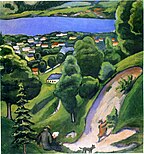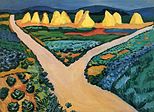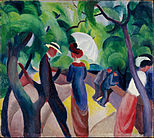
Franz Moritz Wilhelm Marc was a German painter and printmaker, one of the key figures of German Expressionism. He was a founding member of Der Blaue Reiter, a journal whose name later became synonymous with the circle of artists collaborating in it.

Robert Delaunay was a French artist of the School of Paris movement; who, with his wife Sonia Delaunay and others, co-founded the Orphism art movement, noted for its use of strong colours and geometric shapes. His later works were more abstract. His key influence related to bold use of colour and a clear love of experimentation with both depth and tone.
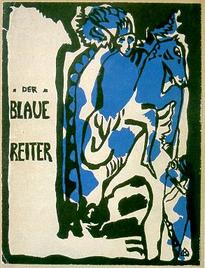
Der Blaue Reiter was a group of artists and a designation by Wassily Kandinsky and Franz Marc for their exhibition and publication activities, in which both artists acted as sole editors in the almanac of the same name. The editorial team organized two exhibitions in Munich in 1911 and 1912 to demonstrate their art-theoretical ideas based on the works of art exhibited. Traveling exhibitions in German and other European cities followed. The Blue Rider disbanded at the start of World War I in 1914.
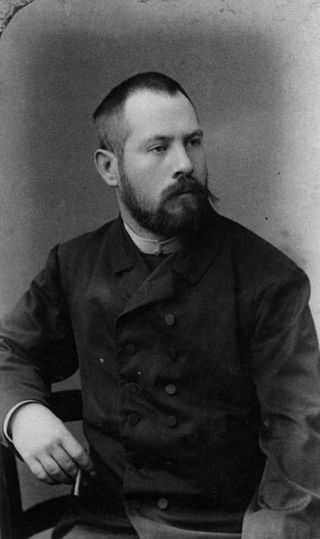
Lovis Corinth was a German artist and writer whose mature work as a painter and printmaker realized a synthesis of impressionism and expressionism.

The Neue Galerie New York is a museum of early twentieth-century German and Austrian art and design located in the William Starr Miller House at 86th Street and Fifth Avenue in New York City. Established in 2001, it is one of the most recent additions to New York City's famed Museum Mile, which runs from 83rd to 105th streets on Fifth Avenue in the Upper East Side of Manhattan.

Otto Müller was a German painter and printmaker of the Die Brücke expressionist movement.

The Lenbachhaus is a building housing the Städtische Galerie art museum in Munich's Kunstareal.

Günther Förg was a German painter, graphic designer, sculptor and photographer. His abstract style was influenced by American abstract painting.

The Kunstmuseum Bonn or Bonn Museum of Modern Art is an art museum in Bonn, Germany, founded in 1947. The Kunstmuseum exhibits both temporary exhibitions and its collection. Its collection is focused on Rhenish Expressionism and post-war German art. It is part of Bonn's "Museum Mile".
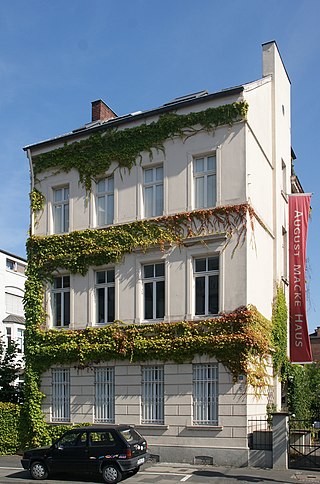
The August-Macke-Haus or August Macke House is a museum in Bonn, Germany, opened in 1991, dedicated to the expressionist painter August Macke. It is located in Macke's former home, where he lived from 1911 to 1914. The museum displays reconstructed interiors and houses temporary exhibitions, usually focusing on Expressionism. In the August-Macke-Haus, Macke's studio has been restored, including furniture from his Tegernsee days. A basic archive of Rhenish Expressionism is available in addition to a reference library.

Elisabeth Erdmann-Macke was a German writer who focused on memoirs of her time as the wife of the expressionist painter August Macke, who had portrayed her more than 200 times. He died in World War I. Later, she lived in Berlin with her second husband, Lothar Erdmann, who died in a concentration camp during World War II. She saved Macke's paintings and copies of his letters by moving them from her house in Berlin before it was bombed in 1943.

Bernhard Koehler was a German industrialist and art collector.

Portrait with Apples, also known as Elisabeth with Apples, is an oil-on-canvas painting executed in 1909 by the German Expressionist painter August Macke. It shows his wife Elisabeth Gerhardt and was created shortly after their wedding. Macke had studied the work of the Fauve artists during his honeymoon in Paris, and the painting shows their influence. It marks the beginning of his public artistic appreciation. The work belongs to the collection of the Städtische Galerie im Lenbachhaus, in Munich.

Indians on Horseback is an oil-on-canvas painting executed in 1911 by the German Expressionist painter August Macke. It was created when the artist was under the influence of Cubism and had joined Der Blaue Reiter group through his friend Franz Marc. The painting belongs to the collection of the Städtische Galerie im Lenbachhaus, in Munich. It was donated by the Bernhard and Elly Koehler Foundation in 1965.

The Donkey Rider is a watercolor created in 1914 by the German Expressionist painter August Macke. It was created during the art-historically significant trip to Tunisia that he took with fellow painters Paul Klee and Louis Moilliet in April 1914. The watercolor is now in the collection of the August-Macke-Haus in Bonn.
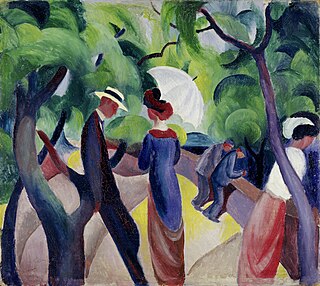
Promenade is an oil-on-cardboard painting by the German artist August Macke, executed in 1913. It is held at the Städtische Galerie im Lenbachhaus in Munich. Chronologically, it is the first of the paintings that he created after moving to Hilterfingen in Switzerland.

Erster Deutscher Herbstsalon was the title of an art exhibition that was organized in 1913 by Herwarth Walden in Berlin.

Large Bright Showcase is an oil-on-canvas painting by the German artist August Macke, executed in 1912. It is held at the Sprengel Museum in Hanover.

Hartmut "Hacky" Ritzerfeld was a German painter of neo-expressive figurative images.









